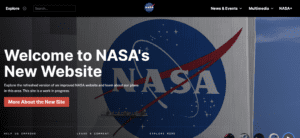What is the U.S. Web Design System?
Few consider the level of variation and customization that goes into designing and developing various types of websites. All types of entities from small or boutique to medium-sized and large businesses to physicians, dentists, and healthcare corporations serve vastly different populations. To properly serve these unique audiences in a way that best suits their wants and needs, each of these organizations requires different functional and design elements.
It isn’t often that we consider that the US government has the same needs: providing helpful, organized, and aesthetically pleasing content for the people of our country, across a plethora of agencies, departments, and organizations.
The U.S. Web Design System was born out of that need – a desire for government organizations to have Web design and development standards so that various governmental organizations can educate and inform the American public with better-organized government websites.

“United States Flag,- 6/2014-, America Flag,” by JeepersMedia is licensed under CC BY 2.0 .
The U.S. Web Design System is a free, open-source toolkit of code and resources that helps Federal agencies build fast, accessible, mobile-friendly websites.
The U.S. Web Design System is an important tool for Federal agencies to create websites that are accessible, responsive, mobile-friendly, and easy to use. The system’s code is flexible and can be easily customized to meet the needs of any Federal agency.
The system is currently used by over 25 Federal agencies, including the FDA, The Social Security Administration, the Department of Veterans Affairs, the IRS, the Department of Education, the GSA, the Department of Homeland Security, the Department of Commerce, the Environmental Protection Agency, Healthcare.gov, Medicaid, and many more.
Why is the U.S. Web Design System important?
The U.S. Web Design System helps Federal agencies create websites that are:
- Accessible: The system includes code and resources to help Federal agencies meet WCAG 2.0 AA accessibility guidelines, and the system was designed with Section 508 compliance in mind.
- Responsive: The system’s responsive themes provide Federal agencies with code that adapts to different screen sizes, making websites accessible on mobile devices.
- Mobile-friendly: The system provides Federal agencies with code to create mobile-friendly websites that load quickly and are easy to use on small screens.
- Consistent: The system includes design patterns, components, and utilities that Federal agencies can use to create consistent websites.
- Fast: The system’s code is lightweight and fast-loading, so Federal agencies can create websites that load quickly on all devices.
What is the history of the U.S. Web Design System?
The U.S. Web Design System was created in 2015 by the Federal government as a way to help Federal agencies create better-designed, more user-friendly websites.
In 2017, the system was updated with new code and resources, including responsive themes, design patterns, components, and utilities. The update was designed to help Federal agencies create websites that are mobile-friendly, fast-loading, and accessible to all users.
How is the U.S. Web Design System developed?
The U.S. Web Design System is developed and maintained by the Federal government, with input from Federal agencies, design and development professionals, and the public. Federal agencies that use the system contribute code back to the project, so that the system can be continuously improved.
The U.S. Web Design System is released under an open-source license, so Federal agencies and the public can use, customize, and contribute to the project.
How is the U.S. Web Design System used?
Federal agencies use the U.S. Web Design System to create websites that are accessible, responsive, mobile-friendly, and easy to use. The system’s code is flexible and can be easily customized to meet the needs of any Federal agency.
How can I learn more about the U.S. Web Design System?
The best way to learn about the U.S. Web Design System is to explore the project’s website, where you can find documentation, code, and resources. You can also join the U.S. Web Design System Community, a community of Federal employees, contractors, and the public who are interested in using the system to create better websites.
Alternatively, if you are looking to implement the U.S. Web Design System in your organization, Lone Rock Point is more than happy to assist you.
What are some benefits of using the U.S. Web Design System?
Some benefits of using the U.S. Web Design System include:
- Consistent design: The system includes design patterns, components, and utilities that Federal agencies can use to create consistent, user-friendly websites.
- Accessibility: The system’s code is designed to meet the needs of all users, including those with disabilities.
- Mobile-friendly: The system’s responsive themes make Federal websites look great on any device.
- Fast loading: The system’s code is optimized for speed.
Why the U.S. Web Design System is necessary
All Government and Federal agency websites should be accessible for all, they should be simple to read, and people should feel confident on the site. Quality and consistency are vital, and this system allows departments, regardless of shape, size or scope, to provide an excellent service to users.
Examples of the USWDS in Use
One of the best ways to develop a feel for what USWDS offers, and why it builds consistency across Federal agencies, is to look at sites built with it. The following sites are examples of USWDS in use, hopefully allowing you to see what the system has to offer.
Glenn Research Center
In their words: “The NASA Glenn Research Center in Cleveland, Ohio designs and develops innovative technology to advance NASA’s missions in aeronautics and space exploration.” Therefore, there is considerable interest in what the Center does, making the website a crucial hub for US and global users.
You can see the Glenn Research Center site at: https://www1.grc.nasa.gov/
U.S. Department of Veterans Affairs
The U.S. Department of Veterans Affairs remain true to the words of Abraham Lincoln, when he said: “To care for him who shall have borne the battle, and for his widow, and his orphan.” The department focuses on health care support for veterans, assisting veterans to understand and collect benefits due to them, and maintaining cemeteries. The organization also has a remit to assist with the Nations’ preparation for future conflict.
To achieve these goals, the department needs a simple and easy to use site that allows users, many with accessibility issues, to seek help and make informed decisions.
You can see the U.S. Department of Veterans Affairs site at: https://www.va.gov/
America’s Seed Fund
The department provides seed funds for early stage R&D work, with no equity in return. The site showcases success stories, to encourage innovation, and provides a platform for interested parties to learn more, and claim funding.
You can see America’s Seed Fund site at: https://seedfund.nsf.gov/
Register to Vote
As the name suggests, the Register to Vote site allows people to register to vote, and to find useful information such as where to vote, what the voter ID requirements are and what the election process is. This is crucial information, which can shape the destiny of the nation, but the information must be straightforward and easy to access and understand.
You can see the Register to Vote site at: https://vote.gov/
How Lone Rock Point and CivicPress Can Help You Manage USWDS
Accessing and understanding the need for USWDS is one thing; implementing it is often an entirely different matter. At Lone Rock Point, we have a strong track record in assisting Federal agencies and Government departments in setting up and maintaining websites which follow the USWDS.
In fact, we’ve developed a WordPress theme called CivicPress that is a WordPress Full Site Editing theme for modernizing government websites using the US Web Design System (USWDS). CivicPress accelerates meeting the objectives defined by the Integrated Digital Experience Act and OMB M-23-22.
CivicPress seamlessly aligns with the US Web Design System, ensuring compliance with the government’s design standards for consistency, accessibility, and user experience. Effortlessly create visually cohesive and accessible websites, amplify engagement, and build trust with the public.
Contact Lone Rock Point today to learn how we can help you or your organization manage USWDS with CivicPress.





